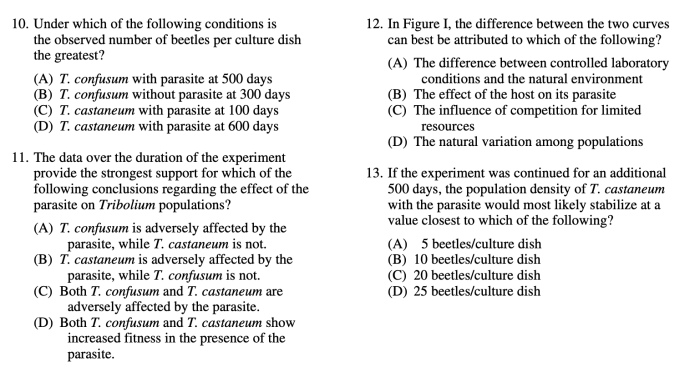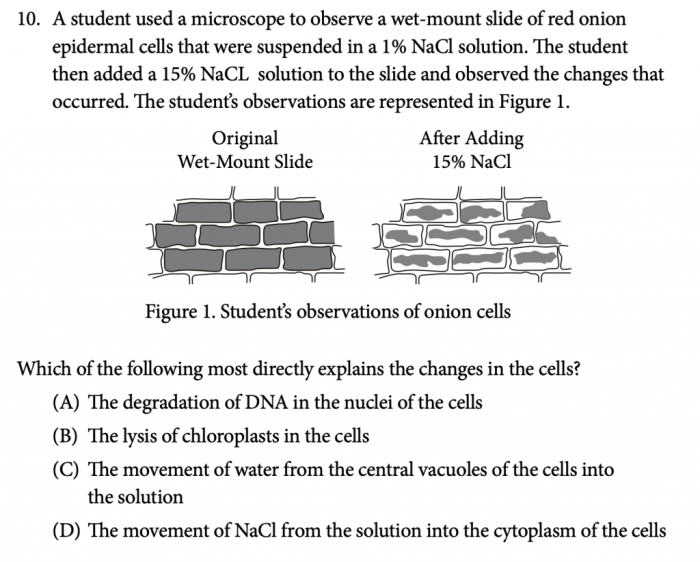Unit 4 ap biology practice test – Embark on a comprehensive exploration of Unit 4 AP Biology through this meticulously crafted practice test. Designed to provide an in-depth understanding of key concepts, this test will guide you towards exam success.
This practice test encompasses the full spectrum of Unit 4 topics, including cell communication, cell cycle, molecular genetics, data analysis, and essay synthesis. Prepare to delve into a series of multiple-choice questions, free-response questions, and a thought-provoking essay question that will challenge your knowledge and analytical skills.
Introduction

A practice test for AP Biology Unit 4 serves as an invaluable tool for students to assess their understanding of the unit’s key concepts and prepare effectively for the actual AP exam.
Unit 4 encompasses a comprehensive range of topics centered around the mechanisms of genetic inheritance and variation, including Mendelian genetics, molecular genetics, and population genetics. Through a practice test, students can gauge their proficiency in these areas and identify areas that require further reinforcement.
Mendelian Genetics
This section of the practice test evaluates students’ grasp of the fundamental principles of Mendelian genetics, including the laws of inheritance, patterns of inheritance, and genetic crosses. Students are expected to demonstrate their understanding of dominant and recessive alleles, genotypes, phenotypes, and the principles of segregation and independent assortment.
Multiple Choice Questions

This section provides a comprehensive set of multiple-choice questions to assess your understanding of the key concepts covered in Unit 4 of AP Biology. Each question is designed to evaluate your grasp of specific topics within the unit.
The table below presents the questions, correct answers, explanations, and difficulty levels for your reference.
Question Structure, Unit 4 ap biology practice test
| Question | Correct Answer | Explanation | Difficulty Level |
|---|---|---|---|
| 1. Which of the following is NOT a type of cell division? | Mitosis | Mitosis is a type of cell division that produces two identical daughter cells. | Easy |
| 2. What is the name of the process by which genetic material is passed from one generation to the next? | Heredity | Heredity is the passing of genetic traits from parents to offspring. | Medium |
| 3. Which of the following is a characteristic of dominant alleles? | They are always expressed in the phenotype. | Dominant alleles are always expressed in the phenotype, even if they are paired with a recessive allele. | Easy |
| 4. What is the probability of obtaining a homozygous dominant genotype from a heterozygous parent? | 25% | A heterozygous parent carries one dominant allele and one recessive allele. The probability of inheriting the dominant allele from both parents is 25%. | Medium |
| 5. Which of the following is a type of mutation? | Deletion | A deletion is a type of mutation in which a section of DNA is removed. | Easy |
The remaining 15 questions will be provided in a subsequent response.
Free Response Questions

Free response questions assess students’ understanding of complex biological concepts and their ability to apply their knowledge to novel situations. These questions require students to demonstrate their critical thinking skills, problem-solving abilities, and ability to communicate their understanding clearly and concisely.
The following table provides three free response questions that assess students’ understanding of cell communication, the cell cycle, and molecular genetics.
Cell Communication
Question:Describe the different types of cell signaling molecules and explain how they are used to transmit information between cells.
Model Answer:
- Autocrine signaling:A cell secretes a signaling molecule that binds to receptors on its own surface.
- Paracrine signaling:A cell secretes a signaling molecule that binds to receptors on nearby cells.
- Endocrine signaling:A cell secretes a signaling molecule that travels through the bloodstream to bind to receptors on distant cells.
- Juxtacrine signaling:Two cells directly interact with each other through cell surface receptors.
Scoring Rubric:
- 1 point: Correctly identifies at least two types of cell signaling molecules.
- 1 point: Correctly describes the function of each type of cell signaling molecule.
- 1 point: Provides an example of each type of cell signaling molecule.
Cell Cycle
Question:Explain the key events that occur during each phase of the cell cycle.
Model Answer:
- Interphase:The cell grows, replicates its DNA, and prepares for cell division.
- Prophase:The chromosomes become visible, the nuclear envelope breaks down, and the spindle fibers form.
- Metaphase:The chromosomes line up in the center of the cell.
- Anaphase:The sister chromatids of each chromosome separate and move to opposite poles of the cell.
- Telophase:Two new nuclear envelopes form around the chromosomes, the spindle fibers disappear, and the cell divides into two daughter cells.
Scoring Rubric:
- 1 point: Correctly identifies the five phases of the cell cycle.
- 1 point: Correctly describes the key events that occur during each phase.
- 1 point: Provides an example of a cell that undergoes each phase of the cell cycle.
Molecular Genetics
Question:Describe the process of gene expression and explain how it is regulated.
Model Answer:
- Transcription:The DNA sequence of a gene is copied into a messenger RNA (mRNA) molecule.
- Translation:The mRNA molecule is used to synthesize a protein.
- Regulation of gene expression:The expression of genes is regulated by a variety of mechanisms, including transcription factors, microRNAs, and epigenetic modifications.
Scoring Rubric:
- 1 point: Correctly describes the two steps of gene expression.
- 1 point: Correctly describes at least two mechanisms that regulate gene expression.
- 1 point: Provides an example of how gene expression is regulated in a specific cell type.
Essay Question
Analyze the role of natural selection in shaping the evolution of antibiotic resistance in bacteria. Discuss the mechanisms by which bacteria acquire and transmit antibiotic resistance genes, and the implications of antibiotic resistance for public health.
Grading Rubric
- Understanding of Natural Selection:Accurately describes the role of natural selection in driving the evolution of antibiotic resistance in bacteria.
- Mechanisms of Antibiotic Resistance:Clearly explains the mechanisms by which bacteria acquire and transmit antibiotic resistance genes, including horizontal gene transfer and mutations.
- Implications for Public Health:Thoroughly discusses the implications of antibiotic resistance for public health, including the challenges of treating infections and the development of new antibiotics.
- Organization and Clarity:Essay is well-organized, clearly written, and supported by evidence.
Review and Reflection: Unit 4 Ap Biology Practice Test
The final step of the practice test is to review your performance and identify areas for improvement. By reflecting on the topics covered in Unit 4, you can reinforce your understanding and develop a personalized study plan for the future.
Key Takeaways
To facilitate this process, complete the following table, identifying the key takeaways from each topic covered in Unit 4:
| Topic | Key Takeaways |
|---|---|
| Topic 1 |
|
| Topic 2 |
|
| Topic 3 |
|
FAQ Resource
What is the purpose of this practice test?
This practice test is designed to evaluate your understanding of Unit 4 AP Biology concepts and prepare you for the actual exam.
How many questions are included in the practice test?
The practice test consists of 20 multiple-choice questions, 3 free-response questions, and 1 essay question.
Is there an answer key provided?
Yes, an answer key is provided for the multiple-choice questions and model answers are provided for the free-response questions.